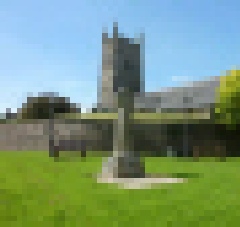



The Parish Church of St George the Martyr, Waterlooville

Quite by chance a few years ago whilst on holiday near Looe in Cornwall Margaret and I spent the afternoon visiting a few local churches. One such was St Nonnas in Pelynt a small village north of Polperro. Near the chancel I immediately noticed an impressive black marble memorial with red lettering commemorating 7 sons of Canon William Shuckforth Grigson appointed vicar of the parish in 1891. After two childless marriages he married his third wife Mary Boldero just before becoming vicar. Seven sons were born between 1892 and 1905 six of whom were to lose their lives in the two World Wars and in Government service.
The first to die was the third son Lionel. A scholar of New College Oxford he was commissioned into the Devonshire Regiment only to be killed on 9 May 1917 when the battalion made a disastrous attack on Fresnoy during the Battle of Arras.
A year later the second brother Kenneth was killed. Commissioned into the West Yorkshire regiment in 1913, he won the Military Cross, only to be killed on 20 July 1918 when the battalion was ordered to recapture the village of Marfaux during the German offensive launched 5 days earlier on the river Marne between Rheims and Epernay. Three months later on 15 October 1918 a third brother, Claude, an R.A.F. cadet aged only 18, died of pneumonia just a month before the Armistice.
The Second World War was to claim two more Grigson brothers. Aubrey, the second youngest, was working in Burma as a Forest Manager for the Bombay Burma Trading Corporation. When the Japanese invaded in December 1941 he was attached to the Burma Army only to be killed by a Japanese bomb at Schwebo in Upper Burma on 27 April 1942.
The eldest son John served with great distinction in World War One as a pilot in the Royal Naval Air Service. Mostly serving in Egypt and Mesopotamia he was awarded the D.F.C. three times and then in 1920 won the D.S.O. for gallant service in Southern Russia. Transferring to the R.A.F. he continued his service career. In April 1941 he was commanding the British Forces in Greece and by 1943 he was in Rhodesia as Acting Commandant (Air Commodore) of the Rhodesian Training Group where young R.A.F. cadets were sent for pilot training. He was killed in a flying accident near Bulawayo on 3 July 1943.
Finally came the loss of the sixth brother Wilfred. He had served in the First World War as a Machine Gun officer in France, Mesopotamia and Palestine. After the war he joined the India Civil Service. He was knighted in the New Years Honour List 1948. By this time he was serving the Government of Pakistan organising the relief and settlement of the thousands of refugee Muslims who had fled from the Punjab following the partition of August 1947.Returning from leave on 26 November 1948 he was a passenger on a Pakistan Airways flight from Karachi to Lahore when the plane crashed near Vehari in the Punjab. All on board were killed. Thus only one brother was left alive. This was the youngest son Geoffrey who had never served in the Forces. He became a poet and art critic. He later published his autobiography "The Crest on the Silver" in which he tells the full story of his tragic family.
John Symonds
Summer Edition 2013
The Grigson Memorial, Pelynt, Cornwall
